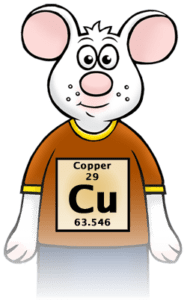I can’t CU
I can’t CU
In this issue
Feature
Conditional KO in 20 weeks
Latest publications
Frank’s blog
Timeline update
 I can’t Cu
I can’t Cu
Copper deficiency is a rare condition, sometimes caused by hereditary disorders. Menkes disease is a severe genetic condition, characterized by copper deficiency, resulting in growth failure, kinky hair, and deterioration of the nervous system. Infants with Menkes disease do not usually live past the age of 3. The X-linked Menkes disease is caused by mutations in the copper transport gene, ATP7A. Mutations in this gene can also lead to other, less severe disorders such as distal hereditary motor neuropathy (dHMNX).
Associate Professor Marina Kennerson is a researcher at the ANZAC Research Institute and the University of Sydney in Australia. Her research interests include Menkes disease, as well as other inherited peripheral neuropathies, which affect the motor and sensory component of the peripheral nervous system. Prof Kennerson focuses on identifying gene mutations that cause these diseases, using the Human Genome Project to map chromosomal regions in affected families. Her work also involves the use of mouse models that mimic the human conditions.
In her latest paper, Prof. Kennerson and her colleagues introduce a conditional Atp7a knock-in mouse model generated by Ozgene. ATP7A is a P-type ATPase essential for cellular copper transport and homeostasis. Many mutations in the ATP7A gene cause severe Menkes disease or its milder allelic variant, occipital horn syndrome. The knock-in mouse, however, models the human X-linked distal hereditary motor neuropathy (dHMNX), which is a non-fatal form of motor neuron disorder.
The mouse expresses Atp7aT985I, the orthologue of the human ATP7AT994I identified in dHMNX patients. Even though a degenerative motor phenotype is not observed, the Atp7aT985I/Y knock-in model shows altered copper levels within the peripheral and central nervous systems, altered myogenin and myostatin gene expression, and an increased diameter of the muscle fibres. The mice have reduced Atp7a protein levels and mimic the defective trafficking and altered post-translational regulatory mechanisms observed in the human ATP7AT994I patient fibroblasts.
The paper demonstrates a unique situation where a specific ATP7A point mutation exclusively causes a non-fatal motor neuron disease. The knock-in model will allow future investigations of the subtle defects in copper metabolism and transport within the nervous system. It will also provide the opportunity to further explore the impact of these pathogenic changes in motor neurons.
For more information regarding Prof. Kennerson’s research, please visit her webpage and see the recent publication below.
For more information on Ozgene mouse models, please see Ozgene services.
 Conditional KO in 20 weeks
Conditional KO in 20 weeks
We have completed a conditional KO project in only 20 weeks, breaking the previous record of 24 weeks. The mouse line was generated on C57BL/6 background, utilising goGermline and gene targeting via homologous recombination. Give our new, faster timelines a go and contact us to discuss your project.
Latest publications
FEATURED – Metallomics. 2016 Jun 13.
Characterizing the molecular phenotype of an Atp7aT985I conditional knock in mouse model for X-linked distal hereditary motor neuropathy (dHMNX).
Perez-Siles G, Grant A, Ellis M, Ly C, Kidambi A, Khalil M, Llanos RM, Fontaine S, Strickland AV, Züchner S, Bermeo S, Neist E, Brennan-Speranza TC, Takata RI, Speck-Martins CE, Mercer JF, Nicholson GA, Kennerson ML. – ANZAC Research Institute, Concord, NSW, Australia. University of Sydney, Sydney, NSW; Deakin University, Burwood, VIC; The Florey Institute of Neuroscience and Mental Health, Parkville, Victoria, Australia. University of Miami Miller School of Medicine, Miami, FL, USA. Sarah Network Rehabilitation Hospitals, Brasilia, DF, Brazil. Concord Hospital, Concord, NSW, Australia. [read]
J Immunol. 2016 Jun 17.
Characterization of the Expression and Function of the C-Type Lectin Receptor CD302 in Mice and Humans Reveals a Role in Dendritic Cell Migration.
Lo TH, Silveira PA, Fromm PD, Verma ND, Vu PA, Kupresanin F, Adam R, Kato M3, Cogger VC, Clark GJ, Hart DN. – ANZAC Research Institute, Sydney, New South Wales; Sydney Medical School, University of Sydney, Sydney, New South Wales; Mater Medical Research Institute, Brisbane, Queensland; Department of Haematology, Royal Prince Alfred Hospital, Sydney, New South Wales, Australia. [read]
Dev Biol. 2016 Jun 10.
Genetic and biochemical evidence that gastrulation defects in Pofut2 mutants result from defects in ADAMTS9 secretion.
Benz BA, Nandadasa S, Takeuchi M, Grady RC, Takeuchi H, LoPilato RK, Kakuda S, Somerville RP, Apte SS, Haltiwanger RS, Holdener BC. – Department of Biochemistry and Cell Biology, Stony Brook University, Stony Brook, NY; Department of Biomedical Engineering, Cleveland Clinic Lerner Research Institute, Cleveland, OH; Complex Carbohydrate Research Center, University of Georgia, Athens, GA, United States. [read]
Frank’s blog: Post-it pandemonium
The humble Post-it notes have become a central part of operations here at Ozgene. They are used in our value stream maps, timeline walls, huddle boards, FMEA analyses, and also occasionally to indicate a problem with the coffee machine. Ozgene’s walls essentially resemble Post-it themed wallpaper. We have the Post-it usage down to a fine art…

 Conditional KO in 20 weeks
Conditional KO in 20 weeks



